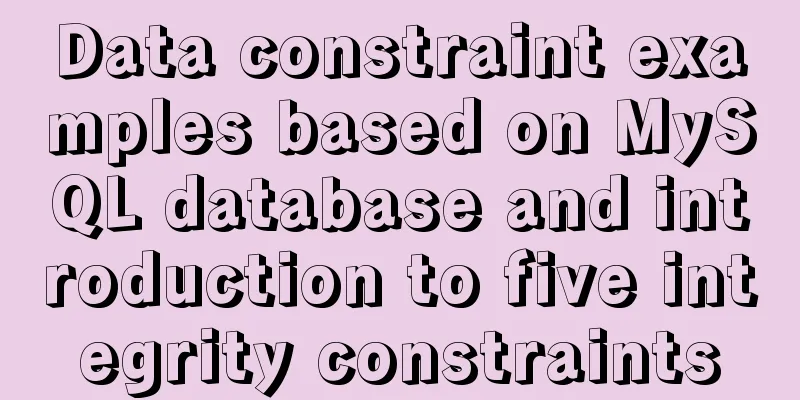Detailed tutorial on how to create a user in mysql and grant user permissions

User Management Create a new usergrammar CREATE USER 'username'@'localhost' IDENTIFIED BY 'password' Example mysql> create user 'lisi'@'localhost' identified by '123123'; Query OK, 0 rows affected (0.00 sec) Username: The username to be created localhost: specifies the hosts that users can log in from, the IP addresses, network segments, and host names that can be logged in. If it is the local machine, you can use localhost. If you want users to log in from any remote location, you can use the wildcard %. mysql> select password(123123); +-------------------------------------------+ | password(123123) | +-------------------------------------------+ | *E56A114692FE0DE073F9A1DD68A00EEB9703F3F1 | +-------------------------------------------+ 1 row in set, 1 warning (0.00 sec //The above code is the encrypted 123123 Password: Because the password enhancement plug-in is enabled in MySQL 5.7, the password cannot be empty and must meet the password complexity requirements and be encrypted before being written to the database. View Current Users select user(); +----------------+ | user() | +----------------+ | root@localhost | +----------------+ 1 row in set (0.00 sec) The created user is saved in the user table of the MySQL database mysql> use mysql; mysql> select user,authentication_string,host from user; +---------------+-------------------------------------------+-----------+ | user | authentication_string | host | +---------------+-------------------------------------------+-----------+ | root | | localhost | | mysql.session | *THISISNOTAVALIDPASSWORDTHATCANBEUSEDHERE | localhost | | mysql.sys | *THISISNOTAVALIDPASSWORDTHATCANBEUSEDHERE | localhost | | lisi | *E56A114692FE0DE073F9A1DD68A00EEB9703F3F1 | localhost | +---------------+-------------------------------------------+-----------+ 4 rows in set (0.00 sec) //lisi is what we added Try to log in to lisi [root@web3 ~]# mysql -ulisi -p Enter password: Welcome to the MySQL monitor. Commands end with ; or \g. Your MySQL connection id is 20 Server version: 5.7.20-log Source distribution //success Rename Usernamegrammar RENAME USER 'old_user'@'localhost' TO 'new_user'@'host' old_user is the old user name, new_user is the new user name. After reloading user lisi, change it to zhangsan. Example mysql> RENAME USER 'lisi'@'localhost' TO 'zhangsan'@'192.168.200.4'; Query OK, 0 rows affected (0.00 sec) View the effect use mysql mysql> select user,authentication_string,host from user; +---------------+-------------------------------------------+---------------+ | user | authentication_string | host | +---------------+-------------------------------------------+---------------+ | root | | localhost | | mysql.session | *THISISNOTAVALIDPASSWORDTHATCANBEUSEDHERE | localhost | | mysql.sys | *THISISNOTAVALIDPASSWORDTHATCANBEUSEDHERE | localhost | | zhangsan | *E56A114692FE0DE073F9A1DD68A00EEB9703F3F1 | 192.168.200.4 | +---------------+-------------------------------------------+---------------+ 4 rows in set (0.00 sec) The renaming is successful, and the host is changed from host to IP address. Set a password for the userThere are two ways to modify user passwords: one is to modify the current user, the other is to modify other users. Method 1 Syntax
SET PASSWORD = PASSWORD('password')
Method 2 Syntax
SET PASSWORD='username'@'host'=PASSWORD('password');
Note: You need to use a new password after logging out Solution to forget root passwordIf you forget the password of another user, you can use the root user to reset it, but if you forget the root user, you must use a special method. Method 1: Stop the mysql service process. Using mysqld_safe with skip-grant-tables to start the database Its function is to not authorize the table when the user logs in. mysql_safe --skip-grant-tables& //At this time, MySQL has been started. Enter MySQL directly without using a password, and use update to change the password. Note: After changing the password, refresh the database flush privileges; Then try to log in with the new password root Authorization ControlPermissions are very important, and assigning permission settings is also very important. Assigning permission libraries to clearly divide responsibilities is the most important thing to ensure the security of the system database. Grant permissions grammar
Common permissions: all, create, drop, insert, delete, update, select Example Add a new user
Assign permissionsgrant all on *.* to lisi@'192.168.1.%' identified by '111111'; Note: When the username and host name do not exist in the database, the username and host name will be created, which is equivalent to adding a user data. The login password is also the password specified later. If your original password is 1212, and the password following grant is different and is 123123, it will be equivalent to changing the password. View permissions SHOW GRANTS FOR 'username'@'host address'; Revoking permissionsStatements
Revoke permissions all revoke all on *.* from lisi@'192.168.1.%'; SummarizeThis is the end of this article about the detailed operations of creating users in MySQL and granting user permissions. For more relevant content about creating users in MySQL and granting permissions, please search for previous articles on 123WORDPRESS.COM or continue to browse the related articles below. I hope everyone will support 123WORDPRESS.COM in the future! You may also be interested in:
|
<<: HTML table markup tutorial (4): border color attribute BORDERCOLOR
Recommend
HTML table markup tutorial (29): cell light border color attribute BORDERCOLORLIGHT
In cells, light border colors can be defined indi...
How to solve the problem of insufficient permissions when switching users in docker container
When switching users in the docker container, it ...
How to use Vue to implement CSS transitions and animations
Table of contents 1. The difference between trans...
MySQL full-text search usage examples
Table of contents 1. Environmental Preparation 2....
The shell script regularly counts the PV of access.log under Nginx and sends it to the API and saves it in the database
1. Statistics of PV and IP Count the PV (Page Vie...
About ROS2 installation and docker environment usage
Table of contents Why use Docker? Docker installa...
JavaScript to achieve click image flip effect
I was recently working on a project about face co...
Design Theory: Ten Tips for Content Presentation
<br /> Focusing on the three aspects of text...
In-depth understanding of the use of Vue
Table of contents Understand the core concept of ...
Detailed steps for Navicat to remotely connect to SQL Server and convert to MySQL
Preface Recently, I encountered a program using S...
How to create WeChat games with CocosCreator
Table of contents 1. Download WeChat developer to...
MySQL Order By Multi-Field Sorting Rules Code Example
Say it in advance On a whim, I want to know what ...
Solution to Vue data assignment problem
Let me summarize a problem that I have encountere...
Use of MySQL truncate table statement
The Truncate table statement is used to delete/tr...
JavaScript single thread and asynchronous details
Table of contents 1. Task Queue 2. To explain som...









